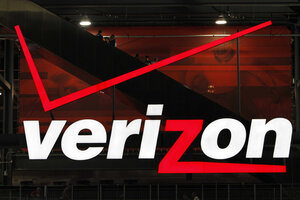Netflix hits pause on Verizon-blaming error messages
Netflix takes down error message that blames Verizon for slow loading speeds, but the streaming service maintains that major Internet Service Providers (ISPs) are to blame for faulty connections.

Verizon and Netflix went back and forth in blog posts this week after Netflix blamed the telecoms company for slow loading speeds in an error message.
Peter Morgan/AP/FILE
Netflix will soon stop pointing fingers at Verizon for slow loading speeds – for now.
Following a highly-public PR battle over the past week in which Netflix flaunted an error message that specifically called out Verizon for slow load speeds and Verizon fought back with a cease-and-desist letter, the streaming service will soon stop specifically calling out the telecom company. With the battle over net neutrality only ramping up, however, the error message may be soon be down but Netflix is definitely not out.
Verizon customers who had issues streaming a TV show or movie on Netflix, such as the second season of Netflix’s original series “Orange is the New Black,” which debuted on Friday, were met with a specifically worded error message from the streaming service:
"The Verizon network is crowded right now," the message said. "Adjusting video for smoother playback…"
The implication was that Verizon, being a major telecom company lobbying for an end to net neutrality in its original form, was intentionally slowing loading speeds because Netflix had not paid for a faster lane of service.
This passive-aggressive note didn’t sit well with Verizon, who filed a cease-and-desist letter for Netflix to stop implying Verizon’s service was the issue, and a strongly worded blog post that says the streaming service has problems of its own that have nothing to do with net neutrality.
"It would be more accurate for Netflix's message screen to say: 'The path that we have chosen to reach Verizon's network is crowded right now,' " says David Young, vice president of federal regulatory affairs for Verizon, in a blog post titled “Shifting Blame.”
Netflix released a blog post on Monday that did not mention the Verizon response, but did indicate the company would take down the specific error posts after June 16, which will conclude a test period for the service that “lets consumers know, while they’re watching Netflix, that their experience is degraded due to a lack of capacity into their broadband provider’s network.” Eventually, however, the company says it will roll this feature out more broadly as part of an effort to be more transparent about loading times and service issues. Netflix has been measuring the speeds of different Internet Service Providers (ISPs) such as Verizon, and in May found that Verizon had some of the slowest loading levels of any ISP.
“Some large US ISPs are erecting toll booths, providing sufficient capacity for services requested by their subscribers to flow through only when those services pay the toll,” says Netflix in its blog. “In this way, ISPs are double-dipping by getting both their subscribers and Internet content providers to pay for access to each other. We believe these ISP tolls are wrong because they raise costs, stifle innovation and harm consumers.”
This argument gets at the main tensions between Internet companies and telecom companies in the fight for new net neutrality rules. Previously, telecoms could not charge any company for better buffer times in an effort to allow both big streaming companies, such as Netflix, and small start-up companies on a level playing field (and to prevent the cost from being pushed onto the consumer). Those rules were thrown out in a court decision involving Verizon in January. Since then, the Federal Communications Commission (FCC) has been reviewing comments from private companies and the public in order to make new rules.
Since then, Netflix, being one of the major users of Internet traffic, has found itself in tangles with several telecom companies. In one highly touted incident in February, just as the second season of its popular original series “House of Cards” debuted, it was forced to pay Comcast extra money to ensure its customers could get series buffered at the same speeds.
However, major telecoms say that Netflix’s buffering speeds have nothing to do with net neutrality, and everything to do with how they choose to connect to ISP networks.
"The source of the problem is almost certainly NOT congestion in Verizon’s network," adds Mr. Young in the blog post. "Instead, the problem is most likely congestion on the connection that Netflix has chosen to use to reach Verizon’s network. Of course, Netflix is solely responsible for choosing how their traffic is routed into any ISP’s network."
As of now, we only have the two companies’ word to go off of, at least until federal rules about transparency in the broadband industry go into effect. In the meantime, expect a lot more blog wars.

